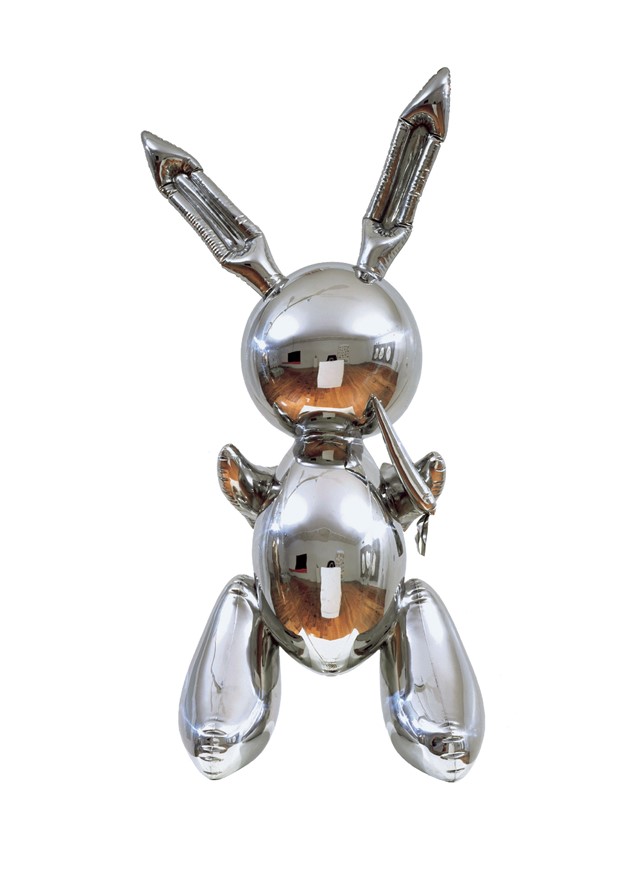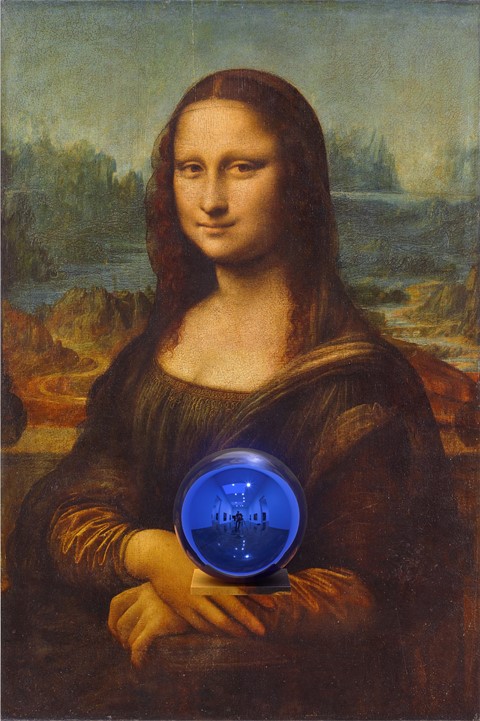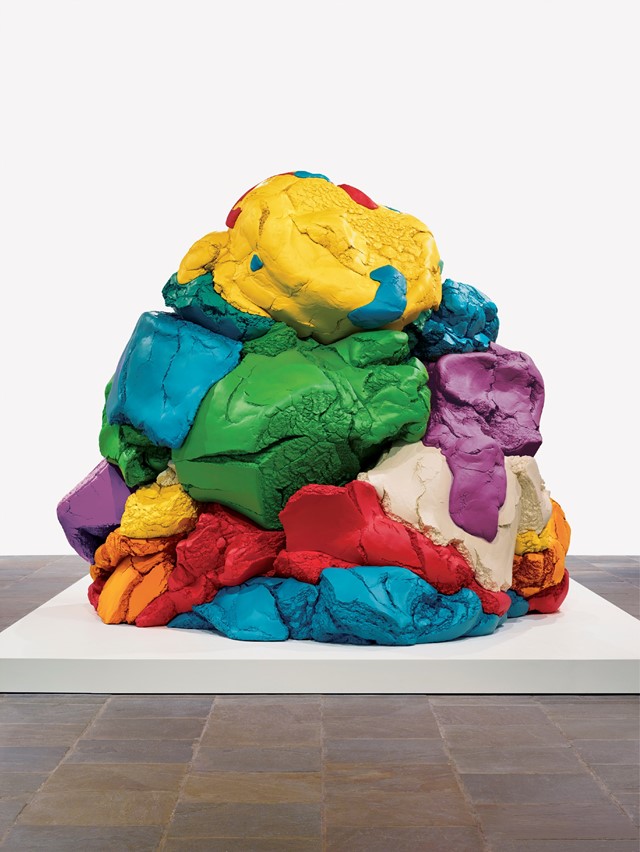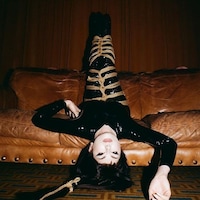Ever wondered what lies beneath those shiny stainless steel surfaces? In honour of his latest exhibition, we take a look at the mysteries surrounding the world’s most expensive living artist
Ah, Jeff Koons. The Marmite of the art world. A name whose mere mention can spark a cacophony of opinions. Some complimentary, many harsh. But everyone has a stance on one of the most contentious artists of our time.
That’s why, when I found myself standing in front of the man, the myth, the artist himself, it felt as if I was on the other side of the looking glass, in a world far from mine. But here he was, waiting in the queue for coffee at Doha’s Qatar Museums Gallery, Al Riwaq, ready to unveil his latest and largest exhibition in the Middle East, Lost in America – just as soon as he’d had his hit of caffeine. He is human, after all.
After his 1986 sculpture “Rabbit” sold in 2019 for $91.9 million, Koons became the world’s most expensive living artist, overtaking David Hockney, who had only held the honour for a few months. His Celebration works, notably “Balloon Dog”, are some of the most photographed artworks in the world, and yet not many of us know what, if anything, lies beneath those shiny stainless steel surfaces.
Lost in America, curator Massimiliano Gioni explained at the press conference for the show, aims to dispel – but also occasionally perpetuate – some of the myths surrounding Koons. Complete with wall text direct from the artist himself, there’s something more personal happening inside this space as the exhibition does its best to unravel an autobiography through an oeuvre that is often described as being executionally astonishing yet conceptually “meaningless”.
“The show is quite rich in different thematic explorations of the myths around Jeff and the myths around American culture,” said Gioni. “So, myself as a curator, I wanted to think of Jeff’s work beyond some of the stereotypes that have often characterised his practice, most notably the auction records, and take a much more intimate look at his work.”
In honour of the exhibition ongoing at the museum until March 31, we bust open and contextualise three of Koons’ biggest myths.

HE’S NOT AN ARTIST BECAUSE HE DOESN’T MAKE HIS ART: FALSE
In the exhibition’s catalogue, Koons muses that he’s been an artist as long as he’s been alive – that “art was always a reward system” in his childhood. Born in 1955 in York, Pennsylvania, Koons was deeply inspired by his father’s work as a decorator. It was through this that his obsession with packaging, aesthetics and environments began to form. “I grew up at a very early age learning that the environment can manipulate your emotions and the way that you feel,” he recalled. “I would go into my father’s store and one week, one room would be a kitchen and the adjoining room would be a living room. I would return the next week, and the kitchen had become a den for people to watch television, and the other room had become a bedroom. I would feel totally different emotions entering that space. I was being manipulated, and I liked it.”
Koons studied painting at the Maryland Institute College of Art in Baltimore and then the School of the Art Institute in Chicago. But it was while working on the membership desk at the Museum of Modern Art in New York City in the 1970s that Koons really found his drive to be an artist. Immersed in works by Picasso, Robert Smithson and Donald Judd, Koons wanted to contribute to the modern art canon. His earliest art was readymade sculptures bought cheaply on New York’s Canal Street, including the pool toys and inflatables he would later become synonymous with through works like “Hulk (Friends)” and “Lobster”. While now, these readymades are meticulously simulated and cast in materials such as bronze or stainless steel – often weighing over a tonne – then, Koons presented them as is, sat atop a mirror. Another series that was noticeably hands-on was Made in Heaven, a set of pornographic images made with his then-wife Ilona Staller, some of which were destroyed during an acrimonious divorce.
“I was always fearful that the material would manipulate me, instead of me manipulating the material” – Jeff Koons
Several years ago, Koons revealed that he employed 100 people to help create his record-breaking work, and he’s been open about his collaborations with artisans from across the globe. Occasionally people have taken issue with this, and use it as a means to dismiss him. But, for Koons, these assistants and artisans keep him closer to the essence of the artwork itself. Speaking to Sheikha Al Mayassa bint Hamad bin Khalifa Al Thani during a talk for Lost in America’s opening weekend, he said: “I was always fearful that the material would manipulate me, instead of me manipulating the material. If I started off wanting to make a vase with flowers with clay, I could end up making a duck. I’ve always enjoyed having more of an idea and then having distance.” His voice is soft, gracious, optimistic, and at times it feels like he’s experiencing something wonderful for the first time – like a wide-eyed child discovering ice cream.
HIS ART IS ONLY SURFACE DEEP: FALSE
Koons’ most recognisable work is undoubtedly Celebration. Even the uninitiated observer will likely recognise the series of mammoth stainless steel sculptures emulating items from a child’s birthday party – a cone-shaped hat, a balloon dog. Made with maniacal precision, these works are mind-bogglingly seamless, identical to their ‘real’ counterparts apart from their outsize stature. “Party Hat” – Koons’ latest addition to the series – took 25 years to be realised, Gioni says during the press tour. Others, like “Balloon Dog” – the most famous of the series – around a decade. It’s a painstaking process that has also been painful in its process. And beyond the surface of the shiny, selfie-ready artworks is a deep personal pain.
Celebration was created in the wake of Koons’ divorce from Staller, the mother of his son, Ludwig, in 1994. The art became an outlet for his grief, initiated after his then-gallerist Anthony d’Offay asked him to create a calendar. Realising the concept was “too good” to only be a calendar, Koons embarked on what would become a decades-long, perilous journey. “For all the myths of success around Jeff, he’s known some very vertiginous ups and downs,” says Gioni. “Celebration is now associated with his masterpiece, but it was initially almost a recipe for disaster.” In fact, the series was so ambitious it almost sent Koons bankrupt in the 1990s and, financially ruined, he moved back in with his parents. Gioni recounted the observation of a gallery director who said: “Jeff is so determined. He loves his work and is so precise that he will get you to jump out of the window. But he’s the only artist I know that will jump with you – that’s how true to his vision he is.” However, somehow, Koons turned it around. Celebration now sells for epic figures.

Koons, Gioni also says, has described “Balloon Dog”, specifically, as a “Trojan horse. “It holds a secret, but it’s up to you to figure out what that is.” Because the balloon is filled with air inside, Koons has said of the work, the attention is focused on its outside, and in particular on the viewers. “The inflatables’ exteriors are also totally reflective, and this constantly reminds the viewers of their existence,” he writes in the exhibition’s catalogue. “To me, Celebration is about the viewers – what their own dreams and memories are. It’s about using the public as a readymade.”
THE SOLE VALUE OF HIS ART IS IN HOW MUCH IT COSTS: FALSE
Despite being some of the world’s most coveted artworks, those shiny surfaces do more than return the viewer’s gaze. Out of the context of Koons’ oeuvre, his favourite material, stainless steel is far from precious: it’s widely available, affordable and durable: a ‘proletariat platinum’. “It’s what we use for pots and pans,” says Gioni, with a laugh. “It has more to do with cooking than fine arts.”
Instead, these inanimate objects ask the viewer to ponder not just their image but what’s inside them, too. “When I’m working with objects, I try to reveal a certain aspect of their personality,” Koons wrote in the exhibition’s catalogue. “I place them in a context or present them in a material that will enhance a specific personality trait within the objects themselves.
“I also try to capture the individual’s desire in the object and to fix that person’s aspirations on the surface, in a condition of immortality. All of this is to say, in the system I was brought up in – western, capitalist system – one receives objects as rewards for labour and achievement. Once these objects have been accumulated, they work as support mechanisms for the individuals: to define the personality of the self, to fulfil and express desire.”

In Lost in America, “Rabbit” is positioned in its own room, gazing on to all the other works – “signalling” the future, Gioni noted. It’s Koons’ pièce de résistance. What began as a cheap inflatable is now the world’s most expensive artwork. You’d be forgiven for thinking that, with Koons’ CV hawking commodities on Wall Street and memberships at MoMA, he’d know how to get people to sit up and pay attention to what he’s saying – or selling. And you’d be correct, but according to Koons, the artwork’s value lies beyond the monetary.
“I don’t seek to make consumer icons, but to decode why and how consumer objects are glorified. My objects reflect desire; they don’t absorb it,” wrote Koons. “I thought stainless steel would be a wonderful material. I could polish it, and I could create a fake luxury. I never wanted real luxury; instead, I wanted proletarian luxury, something visually intoxicating and disorienting. The surface of stainless steel is very much a false front for an underlying degradation.”
Ultimately, Koons said, his artworks are more about ourselves than they are about him. Gioni noted that Koons’ fascination with the readymade moves beyond a philosophical position to the realm of something much deeper: acceptance. “The readymade is the acceptance of the world as it is,” he explained, “and Jeff said if you learn how to accept everything in the world, if you learn that even the most valueless object can become an artwork, the world opens up as a field of endless possibility… The heightened perception that we see in the reflection is an invitation to look at the world more carefully, and to find that rewarding experience in all the objects that surround us.”
Jeff Koons’ Lost in America is at Qatar Museums Gallery, Al Riwaq, Doha, until 31 March 2022. For more information click here









